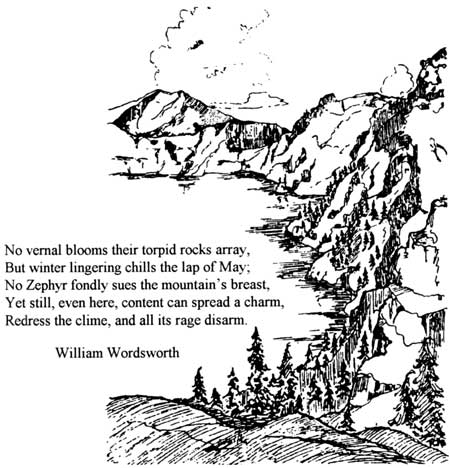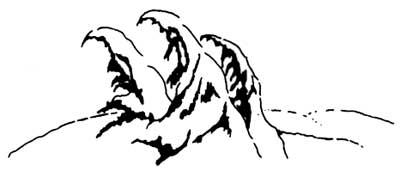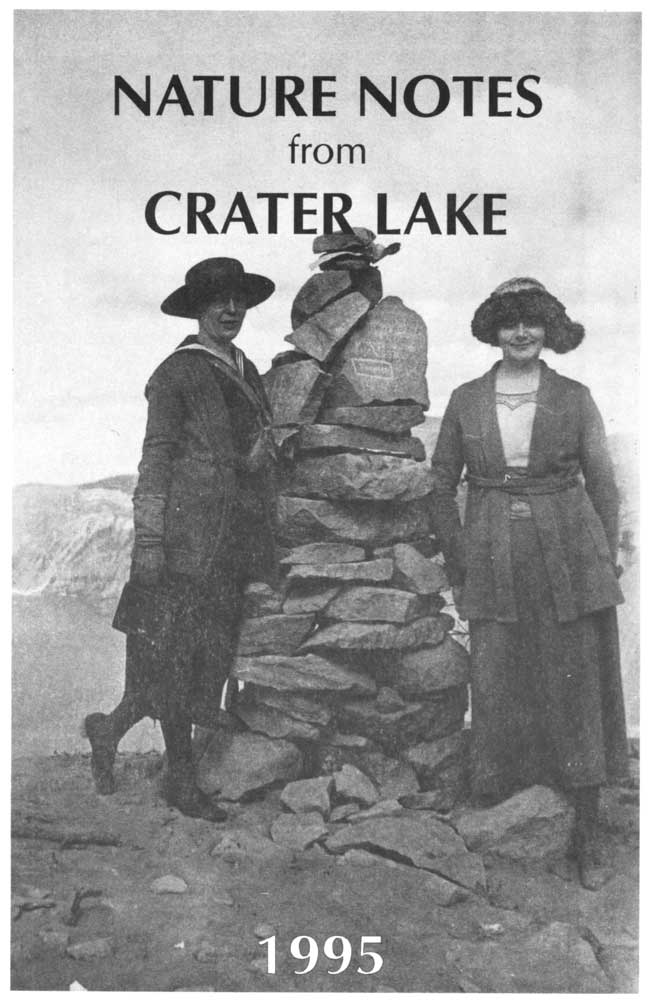Volume 26, 1995
All material courtesy of the National Park Service.These publications can also be found at http://npshistory.com/
Nature Notes is produced by the National Park Service. © 1995
Cover Photo: Two visitors atop Garfield Peak, ca. 1920. Courtesy Mrs. Cole Brown.
Introduction
Present and former park employees have again volunteered their efforts in bringing this volume of Nature Notes to fruition. In addition to thanking the authors, I would like to take this opportunity to acknowledge/he efforts of Susan Marvin and Judy Giles in greatly facilitating the editorial process. Intended as an aid to visitors at Crater Lake National Park and Oregon Caves National Monument, this publication contains original research or observations that should be of interest to anyone wanting more than a fleeting glimpse of either park area. Our hope is, of course, to provide some insights about the character and features of both places.
Since the Crater Lake Lodge reopens this year, I thought it appropriate to begin with an article that relates the hotel to its surroundings. This is followed by an eclectic mix of topics such as porcupines, ponds, and the Pacific Crest Trail which may entice park visitors to get away from their automobiles in favor of going further afield. Toward this end we encourage reprinting submissions that appear in Nature Notes from Crater Lake, as long as credit is given to authors and the Crater Lake Natural History Association.
Established in 1942, the Crater Lake Natural History Association’s purpose is to aid the National Park Service in its educational and resource management programs at Crater Lake National Park and Oregon Caves National Monument. It therefore sponsors this edition of Nature Notes as well as a number of other publications, research grants, and events. The association operates three sales outlets, with two located in Crater Lake National Park and another at the Illinois Valley Visitor Center in Cave Junction, Oregon. Proceeds from sales items are used entirely to support the association’s goals. A list of items available for sale can be obtained by writing to CLNHA’s Executive Director, P.O. Box 157, Crater Lake OR 97604, or by calling (541)594-2211 ext. 499.

Ernest G. Moll, Blue Interval, Portland: Metropolitan Press, 1935, p. 6. Illustration by Karl J. Belser.
No vernal blooms their torpid rocks array,
But winter lingering chills the lap of May;
No Zephyr fondly sues the mountain’s breast,
Yet still, even here, content can spread a charm,
Redress the clime, and all its rage disarm.William Wordsworth
A Naturalist’s View of Crater Lake Lodge
The Crater Lake Lodge will reopen in the spring of 1995 after four years of rehabilitation work. There are just 71 guest rooms in the lodge, but all park visitors are welcome to spend some time in the building. They can relax in the Great Hall, have a meal in the dining room, examine a small exhibit room that centers on the lodge’s history, or wander around the grounds to contemplate Crater Lake and its surroundings. As you might expect, there are many opportunities for observation and study.
Landscaping adjacent to the lodge is a lesser-known component of a more than $15 million rehabilitation project. A separate landscape contract has been let in order to restore lodge grounds impacted during four summers of construction. In addition to historic and aesthetic criteria, the landscape plan addresses erosion and species integrity as two other areas of emphasis.
The effects of erosion can be seen just below the caldera rim. Roots of mature trees are exposed where the soil in which they grew has been worn away. Small-scale erosion in areas disturbed during construction and in newly planted beds is being checked by an erosion control blanket. This consists of wood shavings and a nylon net that will degrade in a few years with exposure to ultraviolet light. Concerns that the net might entangle deer have been alleviated upon observations that the animals traverse the blanket without difficulty.
The genetic integrity of plants placed around the lodge became a prime concern of consulting botanists. They insisted that vegetation planted in the restored landscape be limited to the floral gene pool of Crater Lake National Park. This would insure better adaptation for survival in the harsh environment (deep snows, long winters, dry summers, high elevation) of Rim Village, but also might prevent introduction of non-native species or variants which eventually could compete with native plants. All of the plants used in this project have been propagated from seed collected in the park, or from local cuttings.

Young hemlocks curl over as snow accumulates.
Illustration by Amy Mark, National Park Service files.
All three tree species evident around the lodge are well adapted to the deep snows that fall at Crater Lake. Mountain hemlock, Tsuga mertensiana, with its distinctive droopy leader, is very flexible. Visitors in late fall or early spring might see young hemlocks curling over as snow accumulates, or slowly springing upright as the snow melts. Subalpine fir, Abies lasiocarpa, has also evolved to bend with heavy snow and strong wind. Mature trees display a distinctive spire-like silhouette, in part to shed snow and cut wind resistance. Whitebark pines, Pinus albicaulis, can be identified by clusters of five needles and very limber branches. They are often perched right at the caldera’s edge because their ecological niche permits survival in exposed areas where there is less competition from other species.
Contractors also transplanted a number of shrubs into beds around the lodge. Perhaps more than the trees, shrubs help blend the hotel with its surroundings because they can soften vertical lines imposed by building facades and provide transition between ground and structure. In utilizing a number of well adapted shrubs around the Crater Lake Lodge, this also provides a way to learn something about native plants.
Discovered only in 1896, the Crater Lake currant, Ribes erythrocarpum, is found in only a few areas outside park boundaries. This is a creeping shrub, and may form a large mat with copper-colored flowers in July and red berries in late summer. Waxy currant,Ribes cereum, by contrast, is more bushy and has smoother leaf edges. It can also be distinguished by white or pinkish flowers and yellowish red berries. Botanists found the waxy currant much easier to propagate from in-park sources than Crater Lake currant, perhaps because of its wide distribution at high elevation in dry, open places.
Pinemat manzanita, Arctostaphylos nevadensis, is a low, sprawling shrub that seldom grows more than a foot high. It has red bark on its slender stems, and evergreen, leathery leaves. This type of manzanita is also common along the Cleetwood Cove Trail leading down to the lake. It is one of several shrubs frequently browsed by deer.



